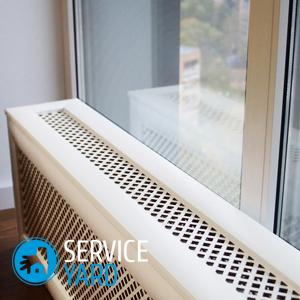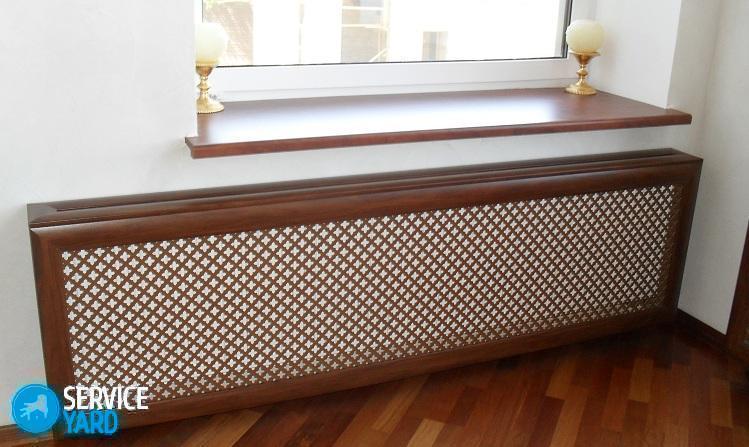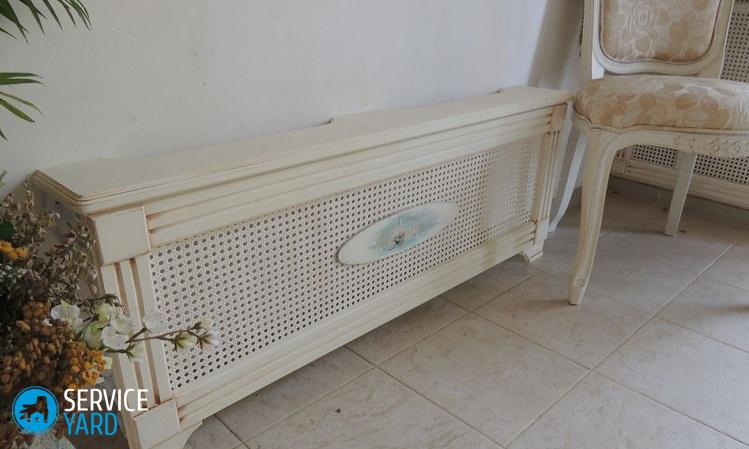How to make a screen on the battery with your own hands?

The presence of a decorative screen on the thermal battery gives the living room a unique zest. But in this case, there is one negative point: when they try to cover the battery with at least something, then there are obstacles for the movement of warm air, as a result, the room becomes cooler. In order to somehow compensate for such a drawback, a heat-reflecting screen is fixed to the wall that is behind the battery. In this article, we will look at how to make a screen on a battery with your own hands.
to contents ↑A little about the heat transfer of radiators
Thermal energy, which is released into the living room by a heating battery, consists of two components - radiant and convective:
- Radiant energy is characterized by the presence of infrared radiation, which enters the room from the hot surface of the radiator. If the coolant does not have a high temperature, which is about 50 ºС, then there is very little radiant energy. But already at 60 ºС, the share of this energy increases significantly.
Important! The exception is water heaters having a convector type. Such radiators do not have front panels hot, so there is practically no radiant energy. But such heaters are very rare.
- The convective component is characterized by the transfer of thermal energy to the environment. The front surfaces of batteries also affect convective energy. They prevent the passage of heat flow through the fins and other elements of the heating battery. In case of unsuccessful design of the decorative box, a significant part of the hot flow can accumulate inside the fabricated casing, while there is no possibility of its exit outside.
Important! In a private house, this situation is not so terrible, since the heating system encircles the whole house, and this heat does not go anywhere, but is simply given to other rooms. But if you live in an apartment, then the heat you paid returns to the neighbors in the riser.
In any case, no matter how the decor of the radiators is installed, losses are fixed in the range from 3 to 7%. It is practically impossible to avoid such losses, but to reduce them to a minimum is quite realistic, for this you just need to make a successful design of the heat shield.
to contents ↑Varieties of battery screens
Installing a decorative screen on the battery can be one of the following system options:
- The presence of a flat screen. Designs from a flat screen are installed when the battery is located under a window sill or in a niche. Thus, the completeness of the interior is created, but at the same time, heat is stored in the room.
- The presence of a hinged roof. The hinged cover is mounted on radiators that protrude. This option is very convenient for creating a miniature table, which is being expanded, and it can be adapted for tea drinking or morning or evening coffee break.
- Creating a box. A box-shaped design completely covers the battery.In this case, it is necessary to ensure that the location of the ventilation holes is made in certain places and in the required quantity.
Materials
Decorative screens can be made of various materials. The most common are:
- glass;
- MDF gratings;
- wood screens;
- decorative covers made of plastic;
- metal;
- from drywall.
Glass
What material to use in order to make the screen on the battery yourself? Designs of glass screens look very stylish and aesthetically attractive. They are currently very popular. Stained or tempered glass screens are exclusive models. Such compositions are used to complement expensive modern interiors for unique design projects.
Important! Glass is a fragile material, so it must be handled with extreme care and very carefully.
Glass is a convenient tool for creativity. Very often, drawings of individual content are applied to an ordinary glass surface.
MDF grating
MDF screens are convenient, inexpensive, practical and reliable. Modern technologies have allowed MDF screens to become an affordable solution to problems with the installation of thermal batteries. There are many options for manufacturing this type of structure.
Wood
Screens for wood radiators are mainly made by reservation. As a rule, solid wood species are used for their manufacture. Such decorative screens fit perfectly into any interior, but they have one negative point. During operation, over time, they are characterized by drying out and possible deformation.
Important! The cost of wood screens is much higher than decorative casings made of MDF.
Plastic
Plastic is a practical, inexpensive, convenient and versatile material. Decorative screens made of plastic are the most affordable, since installing such screens on heating radiators does not require special skills.
Important! They should not be installed in child care facilities, since exposure to high temperatures improves the properties of plastic deformation and melting. In non-residential and office premises, decorative plastic models are the best option.
This type of screens has a huge selection of design and a wide range of color solutions.
Metal
If metal screens for thermal batteries are installed, then basically they have the form of a box made of a thin sheet having a lattice. This type of decorative product can be painted in any color. Metal screens have an affordable price with optimal performance.
Important! Radiator screens can be made of stainless steel. They are more expensive, but from an aesthetic point of view they look great and elegant. Perforated models are especially attractive.
Products made of stainless steel or other metal have the simplest design option. Therefore, it is not difficult to install a decorative screen, since it should simply be hung on a heat battery.
Drywall
Plasterboard sheets are one of the common and popular materials for decoration. Such material is quite suitable for the manufacture of a decorative screen. It's just that making a makeshift gypsum board screen is much more difficult. When working, certain processing skills will be required due to the fragility and certain properties of the raw material.
to contents ↑A few tips before starting installation
There are several ways to increase heat transfer:
- The first method is to use a heat-reflecting screen made of foil material. It must be hung on the wall behind the radiator. In this case, heat is reflected from the screen into the heated room and meaningless heating of the wall will not occur.
- Another method of reducing heat loss - the inner surface of the decorative product must be painted black. With this method, the screen absorbs heat from the radiator and gives it to a heated room to a greater extent.
What to look for when creating a screen?
- How to assemble a screen on batteries and what do you need to remember? When making any kind of panels on a heat radiator, you need to understand that during operation there will be a decrease in heat transfer from the battery. When choosing a blank grid, which has a minimum of holes, the percentage loss ratio increases significantly.
Important! Over the entire heating season, heat meters wind up a significant premium. Therefore, the manufactured decorative screen should have the maximum number of slots so that the unhindered movement of the warm flow is carried out.
- In the manufacture of a decorative structure, it is necessary to provide that it is easily disassembled and removed. Since the thermal battery should be washed, and in the summer period it will also be necessary to drain the water. The constant dismantling of the decorative screen brings additional inconvenience and brings unplanned troubles. In addition, at any time, valves on the battery may be needed, so you need to have unhindered access to them.
Do-it-yourself radiator screen
The easiest way is to make a decorative screen for a radiator from MDF and other wood-based panels on your own.
Materials for work
How to make a screen for a heating battery with your own hands? Consider in detail the instructions that you must first familiarize yourself with before proceeding with the process.
For the manufacture of a decorative screen, the following materials and tools should be prepared:
- A fiberboard sheet having a suitable color scheme. A particle board can be easily processed, it is easy to paint, and the paint adheres perfectly due to the structure of the material. Before sawing, you can either pre-paint the entire sheet, or you can paint an already manufactured product.
- A sheet mesh that is used for installation on the side and front panels.
- Reflective sheet - foil or metal sheets are mainly used.
- Connecting elements, which include screws, staples and nails.
- Glue for carpentry.
Important! In general, the casing for the thermal battery is a box having three sides, a top cover and fasteners, which are located below. To cut and assemble all the details, a special scheme is used. At the end of the workflow, legs are attached, after which the screen can be mounted on a radiator.
Markup
How to make a screen for the battery yourself:
- When making the front panel of the screen, you need to measure both sides of the battery.
- After that add 50 mm to the height and add, respectively, 100 mm to the width.
- First, the front part must be cut out of a metal sheet and after that you can decorate the MDF.
- Then measure the depth of the battery, taking into account the distance to the wall surface, and add another 25 mm. This value corresponds to the width of the sidewalls, and the height must be determined based on the length of the radiator itself, while adding an overflow.
- For the value of the product cover, use the depth of the battery and add 35 mm.
Trimming parts
After applying all the measurements to the circuit, you can begin to cut out every detail:
- For the front and side panels use a chipboard sheet.
- To cut the front profile, an MDF sheet is used, from which rectangles having a width of 110 mm are cut.
- Next, using a hacksaw, an angle of 45 ° is applied at the point at which the elements will join.
- At one rectangle, we cut corners with different directions. In this way, all parts can be joined together using carnations or wood glue.
- The grid is used for the facade arrangement of the window.It has a soft structure, so it is easy to process and can be cut with an ordinary hacksaw.
Important! The grid should have the same dimensions as the front panel of the screen.
Self-assembly of the screen:
- To assemble a screen for the battery, you need, first of all, from a wooden bar to make a frame according to predefined sizes. This design allows you to stably fix all the parts and does not allow the product to "float" from one side to the other.
- In the frame itself, you need to cut a hole to accommodate a pipe or pipe, the center point of which should be at a distance of 75 mm from the placement of the side panels.
Important! Do not forget to install a metal or foil sheet, which has the size of a decorative screen, on the radiator from the back of the wall.
- After completion of the assembly process and landing it on the frame, we decorate the faces of the MDF profile. Applying exactly the same principle, we collect the remaining parts of the product.
Important! Depending on your mounting technology, consider these tips:
- If you make a wooden frame from a bar, then there is no need to make additional fastening to the wall.
- If the frame is not used, then for fixing the box, you can use anchor collets.
The easiest option is to install a decorative screen on the legs. The installed design is not monolithic and it turns out to be quite fragile, but this manufacturing option allows you to reduce the costs and time required to install a decorative product.
to contents ↑Alternative option
If there is no opportunity to purchase or manufacture a decorative screen, then you can apply an alternative. To do this, you can use oil paints and apply a beautifully designed picture to a thermal battery.
to contents ↑Important! It is necessary to apply a drawing not only to the radiator, but also to use the wall section near the battery. In this case, the effect of the lack of volume space is created, since the front panel of the radiator and the wall surface represent the same plane.
Stock footage
In this article, we examined all the features of installing screens on batteries. Choose which option will be more appropriate in your interior and complete the design of the room with quality, because your mood for each day will depend on the received image.
- How to choose a vacuum cleaner taking into account the characteristics of the house and coatings?
- What to look for when choosing a water delivery
- How to quickly create comfort at home - tips for housewives
- How to choose the perfect TV - useful tips
- What to look for when choosing blinds
- What should be running shoes?
- What useful things can you buy in a hardware store
- Iphone 11 pro max review
- Than iPhone is better than Android smartphones





